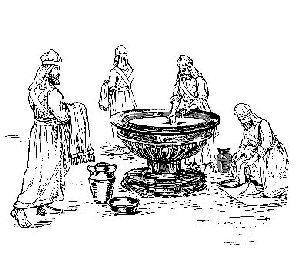Before a priest could enter the Holy Place from the Outer Court, he had to wash at the Brazen Laver. It was a requirement of God that could not be overlooked. He had to remove any defilement before going before the Holy God.
The Laver was made of bronze mirrors donated by women, and was filled with water. It stood between the Brazen Altar and the Holy Place.
Blood was shed at the Brazen Altar symbolizing the sacrifice of a life through death. Water was the focus at the Laver, symbolizing the giving of life through cleansing.
At his initial consecration the priest was washed all over his body at the Laver. This was a type of baptism. After that he had to wash himself – his hands and feet – before entering and after leaving the service to the Lord in the Holy Place. The priest was able to see his reflection both in the water and in the bronze mirrors that made up the Laver. A priest who did not wash before entering the Holy Place, or upon exiting it was considered to be ceremonially unclean, and therefore unfit for service and worship to the Lord.
This is a reminder to us that, after presenting our bodies as living sacrifices (the Brazen Altar experience), we must wash ourselves before entering into intimate communion with, or service to the Lord. How do we do that washing today, since there are no more Brazen Lavers for ceremonial washing? Jesus gives us the answer.
In response to the woman at the well, He said that He had living water that would cause her never to thirst again. This was not physical water to quench natural thirst, but rather the spiritual water of the Word of God that would revive and sustain her. (John 4:1-13)
In John 15:3 Jesus tells His disciples, “You are already clean because of the word which I have spoken to you.”
Paul admonishes husbands to, “love your wives, just as Christ also loved the church and gave Himself for her, that He might sanctify and cleanse her with the washing of water by the word…”
It is clear, then, that our “Brazen Laver” today is the Word of God. Just as the priests were able to see their reflections when they washed at their Laver, we too can see ourselves when we look with honest hearts into the Word. It shows us who we are, and what defilement needs to be removed.
Ask the Holy Spirit to show you, through the Word…
- an attitude that needs to be corrected – is there pride, selfishness, jealousy, unforgiveness
- a sin that you have become desensitized to
- any worldly values that have infiltrated your lifestyle
The priests of Moses’ day had to wash their hands and feet. This was a foreshadowing of what we are to do today. Our hands represent what we do – our work, our service, our assignments. Our feet represent our daily walk – our mindsets, ways, lifestyles.
Today God is too often approached with casual familiarity and taken for granted. Too many believers have adopted an air of entitlement, thinking that because they do x, y or z God must reciprocate. The Sovereignty, Majesty and Holiness of Almighty God has, to a large extent, been excommunicated from the church, and replaced by “God, our good Buddy”. God has been brought down to man’s level, rather than man aspiring to come up to His.
More than ever before, we must look at the Brazen Laver as it relates to us. Although Jesus’ sacrificial death paid the price for our sin, we must still be cleansed daily from its influence. We must ask the Lord to show us, through His Word, what mindsets, attitudes, habits etc need to be removed. Without it we would be in danger of coming before the Holy God with unwashed “hands” and “feet” – defiled priests.
Have you been meeting God’s requirement to wash daily at The “Brazen Laver”?



Amen, Amen & Amen!!!!!
LikeLike